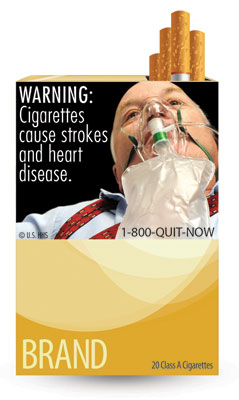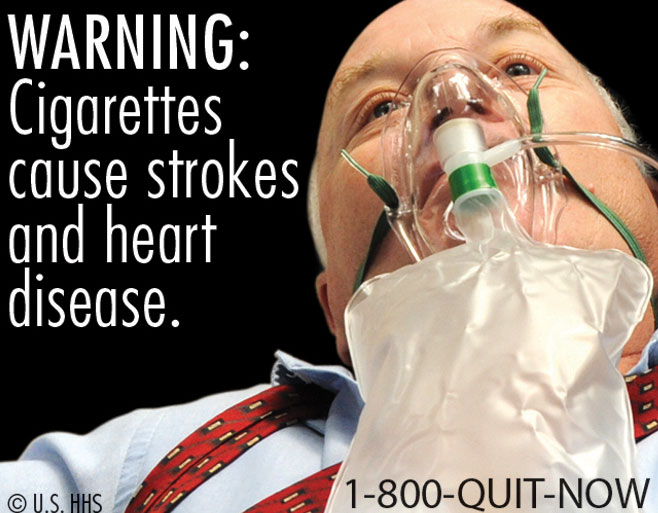Images depicting negative effects of tobacco go up in smoke
Truett Manning
The Signal

The government’s latest attempt to make the public aware that cigarette smoke can be harmful to one’s health was overruled Feb. 29.
The Food and Drug Administration (FDA) released nine new images depicting the negative effects of smoking that it would like to see printed on the top half of both the front and back of cigarette packaging.
Federal Judge Richard Leon tossed out the case, R.J. Reynolds v. U.S. Food and Drug Administration, saying the requirements were a violation of free speech. The FDA plans to appeal that decision and the case is expected to be decided by the Supreme Court.
The images include diseased lungs, rotten teeth and a corpse with its chest stitched up and the words: “Smoking can kill you.” All nine images, which would rotate on the packaging, include a phone number for a stop-smoking hotline and would have to be used in 20 percent of any print advertising the tobacco company does. The FDA created the new images because it feels the current Surgeon General’s warning labels on cigarette packaging is not doing enough to deter young adults from smoking.
Four of the five largest U.S. tobacco companies, including R.J. Reynolds Tobacco Co. and Lorillard Tobacco Co., Commonwealth Brands and Liggett Group LLC sued the federal government in August 2011. The tobacco company Altria Group was not a part of the lawsuit.
R.J. Reynolds Tobacco Co. manufactures cigarette brands such as Kool, Camel, Pall Mall and Winston. Lorillard produces Newport, Kent and Maverick cigarettes. Commonwealth brands include Malibu Slims and Sonoma. Liggett Group LLC produces USA and Grand Prix cigarettes.
William Hoston, assistant professor of political science at UHCL, believes that if the government were to succeed in the printing of these images, it would not cause serious damage to tobacco companies’ current customer base.
“Cigarette boxes, for example, have warnings on them and customer usage has not declined significantly,” Hoston said. “Other factors such as health concerns or the desire to quit has to be at the forefront of individual accountability for customers (users of cigarettes and chewing tobacco) to quit.”
The tobacco companies are fighting the government because they say that forcing these pictures to be printed on their products is a violation of the First Amendment.
“As someone who greatly dislikes being around cigarette smoke, I hate to say I now tend to agree with the cigarette companies that the government is overstepping its boundaries and are quite possibly violating the first amendment,” said Julie Syers, an advertising adjunct at UHCL and senior media buyer for Briggs & Caldwell, Inc.
The Family Smoking Prevention and Tobacco Control Act, which was signed into law June 22, 2009, by President Barack Obama, gives the FDA the power to regulate the tobacco industry. Under the act, tobacco companies are prohibited from sponsoring any athletic, musical, artistic, or other social or cultural event. They are also not allowed to distribute or market any promotional items with the tobacco company logo, symbol, motto, selling message or pattern. These rules were put in place to discourage minors and young adults from smoking.
The tobacco companies have been advertising in the U.S. since the late 1700s, but over the years, they are becoming increasingly limited as to what they can advertise.
In 1964, a report found that lung cancer and bronchitis were closely related to cigarette smoking. That prompted the Cigarette Labeling and Advertising Act of 1965 that required all cigarette packages sold in the U.S. to carry a health warning.
On April 1, 1970, President Richard Nixon signed legislation banning cigarette ads from running on television and radio.
“The government will not succeed in passing legislation to mandate tobacco companies to print graphic images on products,” Hoston said, “Tobacco lobbyists will work with legislators who are on their side to fight against such legislation.”
Tobacco companies argue that printing these images on their packages would cost millions of dollars and urge adult consumers to turn away from their products. The lawsuit says the images were altered and designed to evoke emotion. The tobacco companies claim the corpse photo is actually an actor with a fake scar and the healthy lungs sanitized to make the smokers lungs look worse.
Judge Richard Leon granted a temporary injunction delaying the implementation of the images Nov. 7, 2011, ruling that the images were created to provoke the viewer to quit or to never start smoking.
“If young people don’t already have the sense to refrain from smoking with all the health issues already well-known, putting some graphic pictures on the cigarette packaging is not going to deter the majority of young-adult smokers,” Syers said.
Several tobacco companies were contacted for comment, including R. J. Reynolds Tobacco Co. and Lorillard Tobacco Co. They declined, saying, “We do not comment on pending litigation.”


First off, I’m happy to see the constitution still being recognized and followed per the court ruling. Second, regardless of whether the tobacco co. print the pictures or not, as a past smoker for some 15 plus yrs, If I’m going to smoke because I want and like to, I will, despite any picture on the box.
So what next, pictures of dead bodies or cirrhosis’ liver on a can of beer or whisky bottle? Will not stop those who choose to drink.
Don’t get me wrong, I’d rather people choose not to smoke, as well as drink responsibly (those who do not) as I have a problem w/ my money going to pay for treating those who choose to abuse their bodies who cannot afford to pay for their own healthcare.